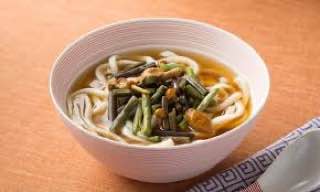When it comes to Japanese cuisine, noodles play an essential role, with udon and soba being two of the most beloved types. But what happens when you combine these classics with the refreshing and earthy flavors of Sansai (mountain vegetables)? You get Sansai Udon Soba—a humble, yet flavorful dish that celebrates Japan’s seasonal bounty.
In this article, I’ll dive into what makes Sansai Udon Soba so special, explore its history, and give you a taste of how this dish showcases the beauty of simplicity in Japanese cooking.
To read about cold noodles click here.
What is Sansai Udon Soba?
At its core, Sansai Udon Soba is a traditional noodle dish made with either udon or soba noodles, served in a light broth and topped with a variety of wild mountain vegetables, known as sansai. The noodles can be thick and chewy like udon, or thin and slightly nutty like soba, depending on the restaurant or your preference. What sets this dish apart is the use of sansai—vegetables foraged from Japan’s mountainous regions, adding a distinctively fresh and rustic flavor to the meal.


The sansai vegetables often used in this dish include:
- Warabi (bracken fern shoots)
- Fuki (butterbur)
- Zenmai (royal fern)
- Yamabudo (wild grape leaves)
- Kogomi (ostrich fern)
These vegetables give Sansai Udon Soba its unique and earthy taste, perfectly complemented by the mild, umami-rich broth, often made from dashi (a soup stock made from kelp and dried fish). The combination of noodles and vegetables makes this dish both hearty and healthy.
To read about Chicken Sashimi click here.
The History Behind Sansai Udon Soba
Japanese cuisine has always been deeply connected to the changing seasons, and sansai plays a significant role in this tradition. In the past, foraging for mountain vegetables was a way for rural communities to make use of nature’s offerings when other crops were scarce. The vegetables were preserved and used throughout the year in a variety of dishes.
Udon and soba, on the other hand, have been Japanese staples for centuries. Udon noodles are believed to have been introduced to Japan from China during the Nara period (710-794), while soba noodles became popular in the Edo period (1603-1868) as a healthy alternative to rice. The pairing of sansai with noodles emerged from the need to incorporate seasonal vegetables into everyday meals, especially in rural and mountainous areas of Japan.
Today, Sansai Udon Soba is enjoyed throughout Japan, especially in regions known for foraging or where fresh produce is limited by the terrain.
To read about best Japanese drinks click here.
How Sansai Udon Soba is Made
Making Sansai Udon Soba at home or in a restaurant is a straightforward but rewarding process. The key ingredients are:
- Noodles: You can choose between udon (thick, wheat noodles) or soba (thin, buckwheat noodles).
- Sansai Vegetables: A mix of mountain vegetables, often pre-cooked or blanched.
- Broth: The base of the soup is usually dashi, but you can also use miso or soy sauce as a base for extra flavor.
- Garnishes: Toppings like green onions, sesame seeds, or a slice of yuzu (Japanese citrus) add extra zest and complexity to the dish.
The dish is assembled by cooking the noodles, preparing the broth, and arranging the sansai vegetables on top. The result is a bowl of hearty, nourishing soup that brings out the best of Japan’s simple yet complex culinary traditions.
To read about Pyongyang cold noodles click here.
Where to Find the Best Sansai Udon Soba
If you’re lucky enough to travel through Japan, you’ll find Sansai Udon Soba served in local eateries, especially in mountainous regions or rural inns (known as ryokan). Some of the best places to enjoy this dish include:
- Nagano Prefecture: Known for its cool climate and proximity to the mountains, Nagano is a hotspot for sansai foraging, making it the perfect place to try authentic Sansai Udon Soba.
- Tohoku Region: Northern Japan’s rugged terrain is another place where mountain vegetables thrive, and here you’ll find variations of Sansai Udon Soba that highlight the region’s specific foraged plants.
In Tokyo, you can find Sansai Udon Soba in traditional soba shops or at specialized noodle houses that offer both udon and soba variations. The earthy flavors and seasonal ingredients make it a dish that showcases Japan’s connection to nature.
To read about Hamhung cold noodles click here.
Final Thoughts on Sansai Udon Soba
At its heart, Sansai Udon Soba is more than just a noodle dish. It’s a culinary experience that connects you to Japan’s rich seasonal traditions and its deep appreciation for nature. The combination of simple noodles, flavorful broth, and fresh mountain vegetables is a reminder that sometimes the best meals are those that highlight the beauty of basic, well-sourced ingredients.
Whether you’re enjoying it in a bustling soba shop in Tokyo or a quiet mountain village in Nagano, Sansai Udon Soba offers a taste of Japan’s past and present, with each bite telling the story of the land it came from. So next time you find yourself craving noodles, skip the ramen and give Sansai Udon Soba a try—you won’t regret it.

